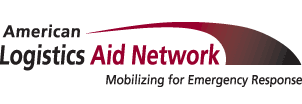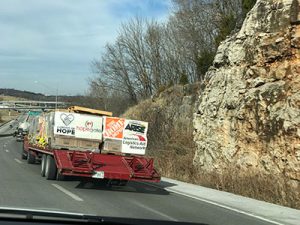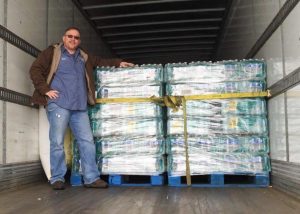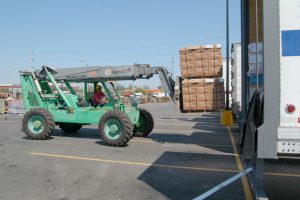There are some “dislikes” you don’t see coming.
For example, ALAN’s communications director Lori, who usually loves all things whimsical, has a head-scratchingly hate-hate relationship with Buc-ee’s. And her opera-buff husband was chagrined to learn that unlike almost everyone else in the world, he detests Andrea Bocelli’s music.
As for me, I really can’t stand product collection drives.
Surprising, right? After all, since I work for a humanitarian organization, you’d think I’d applaud any act of kindness.
Unfortunately I know the truth about these well-intentioned attempts to help disaster survivors. And I think you should, too, which is why I hope you’ll allow me to pass along four not-so-fun-facts about why the disaster relief community usually considers these collective events to be a bane rather than a blessing.
Fact One: Many items that are collected during drives aren’t the types of things that are really needed at disaster sites – at least during the early stages of recovery.
Whenever a disaster hits, many of us instinctively want to load up a truck with the unused contents of our closets, kitchen cabinets or pantries. After all, since disaster survivors have lost so much doesn’t it make sense that they’d find it helpful to receive almost anything?
Not necessarily – and definitely not immediately.
During the early days or weeks after a disaster, the things that most survivors need tend to be very basic: getting rescued, receiving medical treatment, having enough clean water to drink, and having adequate food and shelter.
Any donated item that doesn’t fall into this practical group is unlikely to be of use until much later down the line, perhaps during a disaster’s clean-up or rebuilding phase. And even then, the operative word is “perhaps.”
Fact Two: Even collection drives that focus gathering very practical items don’t always help.
Of course this begs the question: As long as a collection drive is focusing on essential items like water filters, tarps, PPE, medical supplies or inflatable rafts, it’s okay to participate, right?
Sadly, the answer is still usually no.
For one thing, many of the items that are needed to meet survivor’s immediate needs have probably already been acquired by the many government and relief organizations that are providing initial response. For another, even practical items sometimes don’t wind up being truly helpful to the community you’re trying to assist because survivors occasionally have unique dietary requirements or unpredictable shortages that only first responders and other personnel who are working at a disaster site will be familiar with.
At the end of the day, most collection drive contributions wind up overwhelming shelters and rescue sites with extra materials that they don’t have room for or time to deal with – including many that run the risk of spoiling, expiring or getting damaged before they can be used.
Fact Three: Many collection drives aren’t backed by viable plans for getting donated items in disaster survivors’ hands.
When it comes to helping disaster survivors, having your heart in the right place isn’t the same as being able to get your goods to the right place.
While most collection drive organizers totally get the fact that disaster survivors don’t have access to their usual supplies of food, water or other necessities, they fail to consider why (dangerous weather, fallen power lines, flooded roadways, power outages and damaged infrastructures). Just as important, they don’t realize that their own efforts to ship supplies to a disaster site will face those same constraints.
It’s a big reason why many product donations don’t reach disaster sites in time to be of use – and why approximately 50% wind up in a landfill rather than in the hands of disaster survivors.
Fact Four: Collected goods that do wind up getting to disaster sites can often impede early rescue, relief and recovery efforts.
You know that frustration you feel when you’re in the home stretch of preparing for a dinner party and a guest arrives with several unexpected hot dishes that need to be popped into your oven ASAP?
Multiply that by about a zillion, and you have a sense of what first responders and relief workers experience when an individual or company shows up at a disaster site with a surprise truckload of materials it’s hoping to give away.
The work required to accommodate these loads can easily get in the way of existing rescue and relief efforts – and take up what is already a very limited supply of time, space and material handling equipment.
The Bottom Line
I could go on. But you get the idea.
Besides, I’d like to end this article on a high note and offer up a few viable alternatives for how you can truly be of help to survivors before, during and after a disaster.
First, consider donating money instead of products. While this may sound akin to a teenager who insists he only wants money for Christmas, non-profits really do find cash gifts to be the most helpful. They can use these contributions to purchase exactly what’s needed for disaster survivors – often much closer to the disaster site (so that help can arrive sooner) and at a much better price.
Second, think about donating your time. From serving up food at shelters or manning the phone lines to assisting with clean-up and rebuilding efforts, there are countless ways that non-profits would love to put your skills and talents to use, including many that take place long after a disaster has stopped making headlines.
Finally, don’t underestimate the value of contributed logistics services, because when it comes to helping humanitarian organizations reach disaster survivors with critical supplies, few things are more essential or appreciated. The forklift you’re willing to lend, space you’re willing to donate or free LTL or truckload shipping you’re willing to supply can truly be a game-changer. And unlike that can of candied yams, box of diapers or old t-shirt, it won’t wind up in a dumpster.
On behalf of all of us at ALAN, thank you for caring enough to help disaster survivors. And if you happen to stop by Buc-ee’s, don’t be shocked if you run into me – because unlike Lori, I happen to love the place.
Kathy Fulton
Executive Director
American Logistics Aid Network





